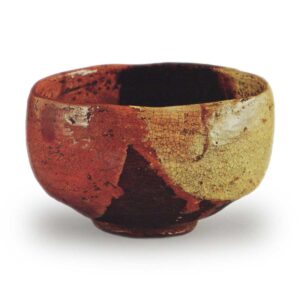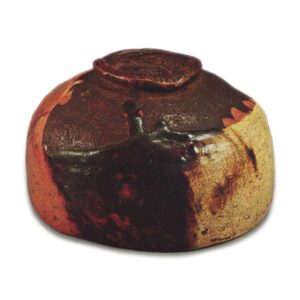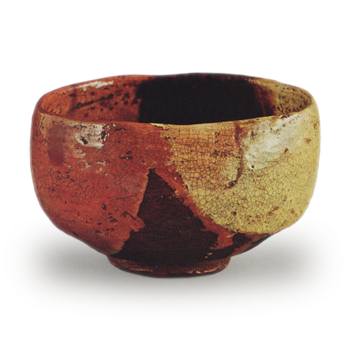

Height: 7.3-7.8cm
Diameter: 10.8-11.9cm
Outer diameter of foot ring: 5.3-5.5cm
Height of foot ring: 0.8-0.9cm
This tea bowl has been in the possession of the Konoike family in Osaka for a long time, and because it was kept in a deep storehouse in the family, it was almost unknown to the world until around the Taisho era.
The Nongou tea bowl is highly creative in its glazing technique, and there are no other tea bowls that have three different layers of red, white and brown. Of the many Nongou tea bowls, this one is particularly decorative.
The shallow, rounded shape is somewhat similar to Koetsu’s black tea bowl “Kuichiga”, and the use of the same candy glaze as Koetsu’s suggests that it was influenced by Koetsu’s tea bowls.
This is a rare Nonko tea bowl with a rough finish, but the roughness is one of the highlights of this tea bowl. In other words, the careless use of the spatula from the foot to the waist can be seen in its original state, as it was shaved, and this is very interesting. And from the way it is done, it seems that this tea bowl was finished at a fairly fast speed.
The clay used for the body is a sticky red clay, which appears to be the same as that used for Koetsu’s tea bowls, but it is not clear whether it is the same type of clay known as Jurakudo. The red clay that Koetsu ordered from Raku Kichizaemon (Jokei) may be the same as this.
The waist area of the piece, which was displayed on a stand, was glazed with a crescent-shaped pattern, and it appears that the glaze was applied in layers, with red glaze applied first, then white and brown glaze.
In other words, it can be seen that red glaze (ochre) is applied under both the yellowish white glaze and the amber-colored glaze, as evidenced by the clear demarcation where the glaze ends. As we are not aware of any other examples of three-color glaze, this is quite a rare find. Furthermore, the glaze is quite thick, and the well-melted glaze surface is covered with slightly rough craquelure.
This is a particularly decorative non-kou tea bowl, but the way it was made is truly unrestrained and unpretentious, and it is interesting in that way. As Takahashi Taian also says in his “Taisho Meiki Kan , if it had been known to the world from an early stage and not been kept in the Konoike family’s collection, it would certainly have been included among the seven non-kou types as a tea bowl with an interesting style and outstanding workmanship.
There are three cracks around the rim, and there is also a long crack, but it has been repaired.
The inscription on the inside of the lid of the box is in the handwriting of Kakuzai Hara So, and it reads “Nonkou red tea bowl, rainbow, left (signature)”. The name “Rainbow” is probably in reference to the three-colored glaze.
On the back of the outer box lid, the inscription “Nonkaw Aka Chawan Kakukakusho Tsuki Niji Hidari (signature)” is by Josai Sosa, and on the front of the lid, the inscription “Nonkaw Aka Chawan Kakukakusho Niji Tori Josai Kokusyo Tsuki Hidari (signature)” is by Nittakusai.



